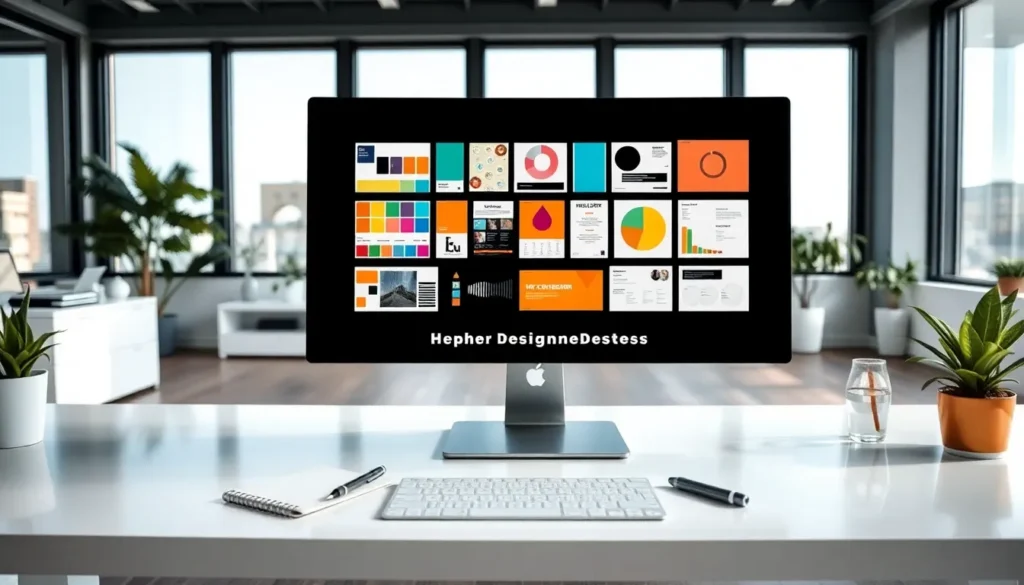Table of Contents
ToggleGraphic design isn’t just a pretty face, it’s a powerful tool that tells stories without uttering a word. From captivating logos to eye-catching posters, graphic design plays a critical role in shaping perceptions and delivering messages. If you’ve ever wondered why some designs leave you speechless while others fall flat, you’re in for a treat. Jump into the world of graphic design concepts that not only dazzle the eye but also resonate with the mind. Buckle up: creativity awaits.
Understanding Graphic Design Fundamentals

To appreciate graphic design, one must start with its core fundamentals. Imagine it as the DNA of all visual projects. Key principles like balance, contrast, emphasis, and alignment serve as guiding lights.
- Balance: This isn’t just about equal weight. Designers often play with symmetry and asymmetry. A balanced design feels stable, ensuring the viewer’s eye doesn’t tire.
- Contrast: This tool sharpens focus. Using contrasting colors or sizes draws attention to the most important elements. Think of text standing out against a bright background as a way to draw a reader in.
- Emphasis: Here’s where the magic happens. Designers create focal points that guide viewers through the design, compelling them to interact. Nobody likes getting lost in design mumbo jumbo.
- Alignment: Ever seen a design where elements seem haphazardly thrown together? That’s a design no-no. Proper alignment establishes order, leading to an aesthetically pleasing layout.
Key Elements of Graphic Design
The building blocks of any captivating design lie in its key elements. These include:
- Line: Whether straight, curved, or jagged, lines guide the viewer’s eye, laying the foundation for other elements.
- Shape: Shapes can be geometric or organic. They create recognition, evoking emotions, and establishing movement within a design.
- Color: Ah, the heart of any graphic. Color choice sets the mood, elicits feelings, and influences behavior. Warm tones evoke energy and passion, while cool tones instill calmness.
- Texture: While graphic design is visual, texture can make it tangible. It adds depth and dimension, inviting the viewer to engage and contemplate.
- Space: The empty areas, or “negative spaces,” ensure a design doesn’t become overwhelming. Think of it as breathing room, allowing the focal points to stand out.
Principles of Graphic Design
Plus to core elements, the principles of graphic design shape how those elements come together. These principles help create harmony and contrast:
- Repetition: Using repeated elements can create consistency and branding. Remember that favorite song on repeat? That’s how repetition works in design.
- Proximity: Grouping related items creates organization. Place a call-to-action near a product image for a clear shopping path.
- Alignment: It’s not just about keeping things tidy. Proper alignment draws the viewer’s eye to what matters most, creating flow.
- Hierarchy: Establishing a visual hierarchy guides viewers, making sure they grasp vital information first. Think of headline fonts being larger: our eyes naturally seek them out first.
Types of Graphic Design
Graphic design isn’t a one-size-fits-all. Different types cater to varying needs and industries:
- Print Design: From business cards to brochures, print designs ensure that tangible materials remain impactful.
- Web Design: With emphasis on user experience, web design marries aesthetics and functionality to create engaging websites.
- Branding: This involves developing a unique identity for businesses. Logos, color schemes, and typography work together to communicate the brand’s message.
- Motion Graphics: Animation adds life to visual storytelling, perfect for advertisements, videos, and interactive media.
- Environmental Design: It merges architecture and graphic design, enhancing physical spaces with signage and other visual components.
Each type has its place and purpose, addressing different facets of communication.
Tools and Software for Graphic Design
Today, designers can harness a plethora of tools and software to bring concepts to life:
- Adobe Creative Suite: The classic powerhouse, with Photoshop and Illustrator leading the charge for image editing and vector graphics.
- Canva: Perfect for those needing user-friendly options. It offers templates and a multitude of design elements, making it ideal for beginners.
- Sketch: Tailored for web and mobile interface design, it’s sleek and builds prototypes seamlessly.
- Figma: This web-based tool allows for real-time collaboration, ensuring teams can work together no matter where they are.
These tools are invaluable, each serving different preferences and needs.
Emerging Trends in Graphic Design
The world of graphic design is ever-evolving, and staying updated is crucial. Here are some emerging trends to keep an eye on:
- Minimalism: Less is indeed more. Clean designs that focus on essential elements are gaining traction. Think bold typography and ample white space.
- 3D Elements: With technology at our fingertips, 3D graphics breathe new life into digital designs, creating depth that captivates.
- Dark Mode: More platforms are supporting dark themes for aesthetic appeal and eye comfort. This trend influences color choices and styles across the board.
- Sustainability: Eco-friendly design elements and practices are becoming paramount as consumers seek brands aligned with their values.
These trends shape the visual landscape, ensuring graphics remain fresh and relevant.







